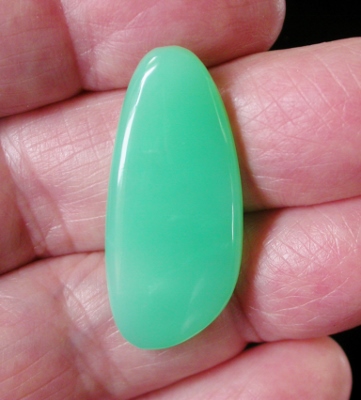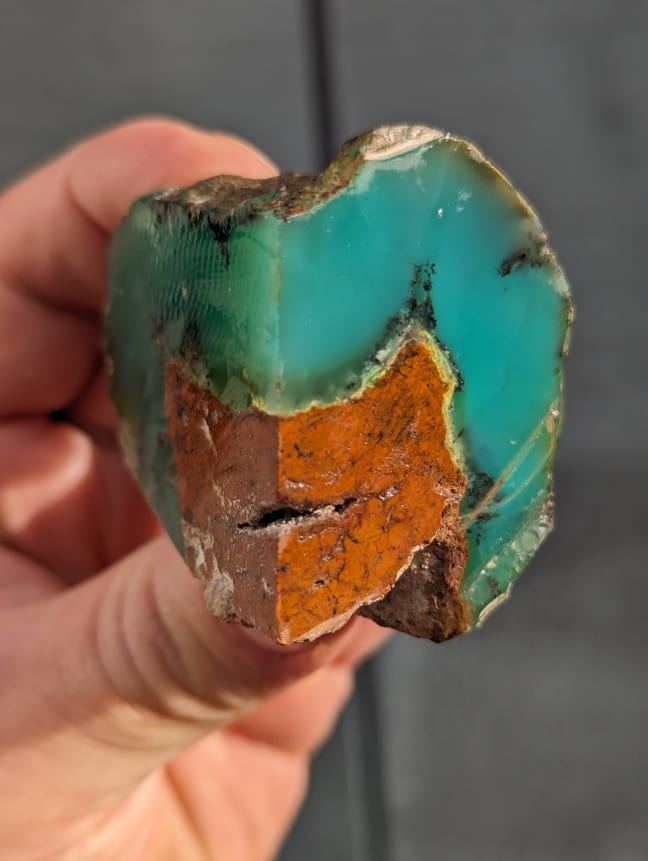|
|
Post by MsAli on Jan 2, 2024 12:24:49 GMT -5
Another beautiful ring
|
|
gemfeller
Cave Dweller 
Member since June 2011
Posts: 4,059 
|
Post by gemfeller on Jan 2, 2024 16:10:03 GMT -5
Great work on both stone and ring. You did a great job of cutting too select the top area of the rough. So much low-end chrysoprase rough has entered the market in the past several decades, many people have forgotten the sublime material that came from Australia's Marlborough Mine for a few years from the 1960s. I was fortunate to be able to get a small amount despite a very limited budget at the time. Here's a Marlborough cab I cut not long ago that proves the some chryso doesn't need to have a high dome to "show the glow."   |
|
goldfinder
Cave Dweller 
Member since December 2020
Posts: 273
|
Post by goldfinder on Jan 2, 2024 17:02:35 GMT -5
What a beautiful ring! Superb job! Thanks so much! Chrysoprase is in my top 10 favorite stones. You did a real nice job with that. I think simple is best to let the stone glow.  Thanks Tela! Yeah it's definitely on my list now. My wife only likes simple designs so I didn't have too many options lol. |
|
goldfinder
Cave Dweller 
Member since December 2020
Posts: 273
|
Post by goldfinder on Jan 2, 2024 17:20:51 GMT -5
Great work on both stone and ring. You did a great job of cutting too select the top area of the rough. So much low-end chrysoprase rough has entered the market in the past several decades, many people have forgotten the sublime material that came from Australia's Marlborough Mine for a few years from the 1960s. I was fortunate to be able to get a small amount despite a very limited budget at the time. Here's a Marlborough cab I cut not long ago that proves the some chryso doesn't need to have a high dome to "show the glow."   Thanks so much for the kind words! That is a very beautiful cab and certainly has that nice glow! Yes I noticed a lot of the chrysoprase rough for sale online is very low quality, yet still asking very high prices. I'm not sure exactly what part of Australia the chunk I bought is from. I think the lighter seafoam blue/green color of this chunk is considered lower grade, than the traditional apple green, but I'm really liking it. It really reminds me of gem silica. This is the rough chunk I cut the cab from, the backside is riddled with that soft red matrix. I'd love to find out where this stuff was mined to buy more.  |
|
gemfeller
Cave Dweller 
Member since June 2011
Posts: 4,059 
|
Post by gemfeller on Jan 2, 2024 18:17:47 GMT -5
I consider the color of the rough you cut the the stone from to be very high grade. Good job with that difficult rough!
Chrysoprase is, technically, a gem siliica. So-called "gem silica" is chalcedony colored by chrysocolla. Chrysoprase is chalcedony colored by nickel. I have chalcedony stones from Peru that are colored my malachite and some that are mixtures of several chromophores. They're all beautiful examples of gem chalcedony with different coloring agents. I think the names in use for these various gems are not precise and instead confusing. The origin of the name "chrysoprase" itself is confusing. "Chrysos" is the Greek name for gold and "Prase" means green. So far I've never seen gold-green chrysoprase.
|
|
|
|
Post by rockjunquie on Jan 2, 2024 18:32:23 GMT -5
"Chrysos" is the Greek name for gold and "Prase" means green. So far I've never seen gold-green chrysoprase. Maybe it was very highly valued and treasured like gold. |
|
gemfeller
Cave Dweller 
Member since June 2011
Posts: 4,059 
|
Post by gemfeller on Jan 2, 2024 19:01:32 GMT -5
"Chrysos" is the Greek name for gold and "Prase" means green. So far I've never seen gold-green chrysoprase. Maybe it was very highly valued and treasured like gold. Could be since it's a combining form used in several other gem names like chrysoberyl, chrysocolla, chrysolite, chrysotile, though several of those have actual gold color. |
|
goldfinder
Cave Dweller 
Member since December 2020
Posts: 273
|
Post by goldfinder on Jan 2, 2024 22:00:46 GMT -5
I consider the color of the rough you cut the the stone from to be very high grade. Good job with that difficult rough! Chrysoprase is, technically, a gem siliica. So-called "gem silica" is chalcedony colored by chrysocolla. Chrysoprase is chalcedony colored by nickel. I have chalcedony stones from Peru that are colored my malachite and some that are mixtures of several chromophores. They're all beautiful examples of gem chalcedony with different coloring agents. I think the names in use for these various gems are not precise and instead confusing. The origin of the name "chrysoprase" itself is confusing. "Chrysos" is the Greek name for gold and "Prase" means green. So far I've never seen gold-green chrysoprase. Excellent info! I knew they were both types of chalcedony but that makes sense it's just different chromophores, or mixtures of chromophores, giving them their different colors. Thanks a lot for the detailed info! |
|